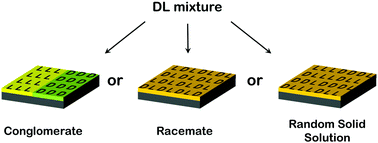Enantiomer surface chemistry: conglomerate versus racemate formation on surfaces
Abstract
Research on surface chirality is motivated by the need to develop functional chiral surfaces for enantiospecific applications. While molecular chirality in 3D has been the subject of study for almost two centuries, many aspects of 2D chiral surface chemistry have yet to be addressed. In 3D, racemic mixtures of chiral molecules tend to aggregate into racemate (molecularly heterochiral) crystals much more frequently than conglomerate (molecularly homochiral) crystals. Whether chiral adsorbates on surfaces preferentially aggregate into heterochiral rather than homochiral domains (2D crystals or clusters) is not known. In this review, we have made the first attempt to answer the following question based on available data: in 2D racemic mixtures adsorbed on surfaces, is there a clear preference for homochiral or heterochiral aggregation? The current hypothesis is that homochiral packing is preferred on surfaces; in contrast to 3D where heterochiral packing is more common. In this review, we present a simple hierarchical scheme to categorize the chirality of adsorbate–surface systems. We then review the body of work using scanning tunneling microscopy predominantly to study aggregation of racemic adsorbates. Our analysis of the existing literature suggests that there is no clear evidence of any preference for either homochiral or heterochiral aggregation at the molecular level by chiral and prochiral adsorbates on surfaces.

- This article is part of the themed collection: Fundamental insights into interfacial catalysis


 Please wait while we load your content...
Please wait while we load your content...